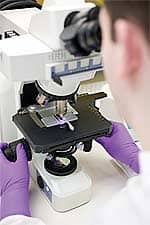Life Extension Magazine®
Low Vitamin D Levels Linked With Depression | |
| A new study shows for the first time that older people with low levels of vitamin D and elevated levels of parathyroid hormone (PTH, a hormone that regulates blood calcium levels) are more likely to be depressed than those with normal levels.* In this study, Dutch researchers measured levels of 25-hydroxyvitamin D and PTH in 1,282 participants aged 65 to 95, of whom 26 were suffering from major depression and 169 from minor depression. They found 25-hydroxyvitamin D levels to be 14% lower in depressed subjects (average: 19 ng/mL) than non-depressed subjects (average: 22 ng/mL). In both depressed and non-depressed participants, vitamin D was far below optimal ranges of 50-60 ng/mL of 25-hydroxyvitamin D of blood, indicative of how pervasive vitamin D deficiencies have become. Serum PTH levels were 33% higher in those with major depression compared with their non-depressed counterparts. Higher PTH can be caused by inadequate vitamin D status. —Dayna Dye | |
| Reference | |
| * Hoogendijk WJ, Lips P, Dik MG, Deeg DJ, Beekman AT, Penninx BW. Depression is associated with decreased 25-hydroxyvitamin D and increased parathyroid hormone levels in older adults. Arch Gen Psychiatry. 2008 May;65(5):508-12. | |
Common Class of Drugs Accelerates Mental, Physical Decline in Elderly | |
| Anticholinergic medications, which are commonly used for conditions like overactive bladder, motion sickness, and asthma, may hasten functional and cognitive decline in older adults, according to new research.1-3 Anticholinergics selectively block receptors for acetylcholine, a neurotransmitter involved in motor function and memory. A study presented at the American Academy of Neurology showed that healthy older adults using anticholinergic medication experienced a 1.5 times faster rate of cognitive decline than subjects not using the medications. Medications used to treat bladder disorders were the most problematic.1 A related presentation from the American Geriatric Society reported that older adults using anticholinergics demonstrated slower walking speed and were more likely to need help with activities of daily living compared with people who did not take the drugs. Taking one moderately anticholinergic drug simulated an extra three to four years of age.2 These findings dovetail with a recent study showing that older adults who used medications for dementia and overactive bladder had a 50% faster rate of functional decline compared with adults who only used medication for dementia.3 While anticholinergics can be useful medicines, physicians and patients should be aware that they can accelerate physical and cognitive decline. —Dale Kiefer | |
| Reference | |
| 1. Available at: http://www.nlm.nih.gov/medlineplus/news/fullstory_63573.html. Accessed May 9, 2008. | |
Olive Oil Substance is Excellent Fish Oil Preservative, Antioxidant | |
| Adding the olive oil polyphenol hydroxytyrosol to fish oil and fish oil-rich food products preserves freshness and dramatically improves their shelf life, according to a new study published in the Journal of Agricultural and Food Chemistry.1 While fish oil has long been valued for its healthful benefits, protecting its delicate fats against oxidation has posed a technical challenge for nutritional scientists. Manufacturers routinely add the artificial preservative, propyl gallate to prevent unwanted oxidation of omega-3 fatty acids and/or vitamin E. Spanish investigators conducted experiments on several fish products and determined that natural olive oil-derived hydroxytyrosol was as effective as the synthetic preservative in preserving the integrity of omega-3 fatty acids and vitamin E.1 For years, Life Extension has included olive oil polyphenols in its Super Omega-3 EPA/DHA with Sesame Lignans & Olive Fruit Extract formulation, based on the excellent antioxidant and lipid-lowering profile of these unique phytochemicals.2 These recent findings confirm that olive oil polyphenols enhance the benefits of fish oil. —Dale Kiefer | |
| Reference | |
| 1. Pazos M, Alonso A, Sánchez I, Medina I. Hydroxytyrosol prevents oxidative deterioration in foodstuffs rich in fish lipids. J Agric Food Chem. 2008 May 14;56(9):3334-40. | |
Weight Loss Critical in Diabetes Management | |
| Overweight patients with type 2 diabetes should lose weight, rather than take ever-increasing doses of insulin, according to diabetes researcher, Roger H. Unger, MD. In a commentary that appeared recently in the Journal of the American Medical Association,1 Dr. Unger noted that the current paradigm regarding type 2 diabetes focuses on patients’ high blood sugar levels, and involves treatments designed to reduce blood sugar, often through intensive insulin therapy. But insulin resistance and the failure of pancreatic beta cells to produce adequate insulin are the result of lipotoxicity, or fatty acid poisoning, according to a new view of the disease.2 Fat cells release substances that contribute to insulin resistance, including adiponectin, resistin, tumor necrosis factor-alpha, and interleukin-6.3 The logical remedy is to reduce or remove the problem—excess body fat—rather than escalate insulin doses. High levels of insulin only contribute to the problem, says Dr. Unger, by shifting excess glucose to fatty acid production, thus increasing the fatty acids that cause diabetes in the first place. —Dale Kiefer | |
| Reference | |
| 1. Unger RH. Reinventing type 2 diabetes: pathogenesis, treatment, and prevention. JAMA. 2008 Mar 12;299(10):1185-7. | |
Fish Oil Improves Infants’ Cognitive and Motor Function | |
Infants exposed to a high level of docosahexaenoic acid (DHA) prenatally have improved mental and motor development, according to a study of native Inuit in Arctic Quebec.* DHA is an omega-3 polyunsaturated fatty acid found abundantly in fatty fish that is a staple of the Inuit diet. The level of DHA was measured in umbilical cord blood of 109 Inuit infants and compared with growth and development at 6 and 11 months. A higher DHA level obtained prenatally from the mother was associated with longer gestation, better vision at six months, and better mental and psychomotor development at 11 months. Postnatal DHA intake from breast- feeding was not significantly associated with any outcome variables. Umbilical cord DHA concentrations correlated highly with maternal concentrations, indicating that the fetus depends on the mother’s polyunsaturated fatty acid intake. Omega-3 fatty acids play a role in third-trimester brain and visual development and are critical in the maternal diet. —Laura J. Ninger, ELS | |
| Reference | |
| * Jacobson JL, Jacobson SW, Muckle G, Kaplan-Estrin M, Ayotte P, Dewailly E. Beneficial effects of a polyunsaturated fatty acid on infant development: evidence from the Inuit of Arctic Quebec. J Pediatr. 2008 Mar;152(3):356-64. | |
Nuts Reduce Cholesterol via Monounsaturated Fatty Acids | |
Adults who consume a short-term macadamia nut-enriched diet have significantly lower cholesterol levels than those who consume a control diet.* Macadamia nuts contain low levels of saturated fats and high levels of monounsaturated fatty acids. In this five-week study, 25 men and women with slightly elevated cholesterol were randomly assigned to the macadamia diet (1.5 ounces/day) or an average American diet. Total fat in the diets was the same; only the percentages of saturated and monounsaturated fats differed. At five weeks, the macadamia diet was associated with a 9% reduction in both serum total cholesterol and low-density lipoprotein (LDL) compared with controls. Other cholesterol measures, such as the ratio of LDL to beneficial high-density lipoprotein (HDL), also improved significantly after the macadamia diet. Research studies show that nuts are beneficial to reduce levels of LDL and prevent cardiovascular disease. This study indicates that macadamia nuts are a good substitute for saturated fats in the diet. —Laura J. Ninger, ELS | |
| Reference | |
| * Griel AE, Cao Y, Bagshaw DD, Cifelli AM, Holub B, Kris-Etherton PM. A macadamia nut-rich diet reduces total and LDL-cholesterol in mildly hypercholesterolemic men and women. J Nutr. 2008 Apr;138(4):761-7. | |
DHEA Inhibits Endothelial Inflammation | |
Scientists have shown that dehydroepiandrosterone-sulfate (DHEA-S) inhibits inflammation in human endothelial cells.* Inflammation and endothelial dysfunction are intimately connected with atherosclerosis, the root cause of cardiovascular disease. Investigators hypothesized that DHEA-S reduces inflammation in the vascular endothelium (cells lining blood vessels). They incubated endothelial cells from human aortas with DHEA-S for 48 hours and then exposed the cells to tumor necrosis factor-alpha (TNF-alpha), a known instigator of inflammation. DHEA-S significantly inhibited the subsequent production of inflammatory proteins ordinarily triggered by TNF-alpha. The results demonstrated the ability of DHEA-S to “directly inhibit the inflammatory process,” and showed “a potential direct effect of DHEA-S on vascular inflammation that has implications for the development of atherosclerotic cardiovascular disease,” investigators concluded. —Dale Kiefer | |
| Reference | |
| * Altman R, Motton DD, Kora RS, Rutledge JC. Inhibition of vascular inflammation by dehydroepiandrosterone sulfate in human aortic endothelial cells: Roles of PPARalpha and NF-kappaB. Vascul Pharmacol. 2008 Feb-Mar;48(2-3):76-84. | |
Vitamin K2 May Protect Against Prostate Cancer | |
| A new European study published in the American Journal of Clinical Nutrition suggests that men with the highest intakes of vitamin K2 have the lowest risk of prostate cancer.* Intakes of vitamins K1 and K2 were statistically compared with the incidence of total and advanced prostate cancer cases in more than 11,000 men participating in the ongoing European Prospective Investigation into Cancer and Nutrition trial. Investigators compared estimated dietary intakes of vitamin K1 and vitamin K2 with the incidence of total and advanced prostate cancer. Subjects were followed for an average of 8.6 years. Men who consumed the highest levels of vitamin K2 (but not vitamin K1) demonstrated a modestly lower incidence of prostate cancer. Higher vitamin K2 intake was particularly protective against advanced prostate cancer. “Further studies of dietary vitamin K and prostate cancer are warranted,” the authors concluded. —Dale Kiefer | |
| Reference | |
| * Nimptsch K, Rohrmann S, Linseisen J. Dietary intake of vitamin K and risk of prostate cancer in the Heidelberg cohort of the European Prospective Investigation into Cancer and Nutrition (EPIC-Heidelberg). Am J Clin Nutr. 2008 Apr;87(4):985-92. | |
US Congress Seeks to Reverse FDA’s Blockade on Estriol | |
The US Congress is taking a key step in attempting to overturn the FDA’s action to halt the sale of estriol. The FDA recently sent out a series of warning letters to compounding pharmacies across the country demanding they stop using estriol and the term bioidentical in their hormone-replacement formulas. The attack by the FDA followed a citizen’s petition filed by the pharmaceuticals giant, Wyeth, which has effectively denied hundreds of thousands of women access to many natural bio-identical hormones that doctors have prescribed for them, forcing them to use standard pharmaceuticals instead. In announcing its decision, the FDA admitted that this action was not over any adverse event or health issue associated with estriol. Instead, it appears to be directly related to Wyeth’s request to eliminate competition for its own hormone-replacement therapies. Resolution 342 is being backed by notable members of the Congress and is calling on the FDA to lift the restriction on prescriptions containing estriol and protect Americans’ access to compounded bioidentical hormone therapies. Up to 80% or more of these custom-made treatments for women contain estriol, which is chemically identical to the naturally occurring hormone produced by women, especially during the third trimester of pregnancy, and which has been used successfully and without problems for decades. There are significant differences between Wyeth’s hormone drug Premarin® (conjugated estrogen) and bioidentical hormones. Premarin® is derived from pregnant horse urine, while estriol is chemically identical to what the human body produces. Premarin® has been shown to increase the risks of cancer and vascular disease,1,2 which have resulted in Wyeth being ordered to pay multimillion dollar court settlements following guilty verdicts that the company concealed a material fact about the safety of the product. Wyeth is also fighting over 5,000 similar lawsuits of fraud across the country. Estriol, on the other hand, is a natural ingredient that cannot be patented and is therefore unavailable for exploitation by a drug company. In essence, Wyeth is seeking to use the FDA to eliminate healthy market competition as more women choose estriol in its bioidentical form. A number of studies have shown that estriol is effective in relieving menopausal symptoms such as hot flashes, diminished libido, vaginal dryness, irritability, depressed mood, and bone loss.3-6 Estriol provides many of the benefits of pharmaceutical hormone drugs but without the harsh side effects.7 The FDA’s action is essentially implying that the side effects of Premarin® apply to bioidentical hormone therapies, but the studies that showed increased risks only examined Wyeth’s products and not these natural therapies. The support of the US Congress on this issue is welcome news indeed, given the FDA’s own recent admissions that it is incapable of keeping up with advances in science8 that could save millions of lives. You can support women’s right to choose their own treatment and the rights of practitioners to practice medicine by emailing your Congressional Representative to support Resolution 342 on estriol by logging onto https://www.lifeextension.com/lac/. —Bina Singh | |
| Reference | |
| 1. Rossouw JE, Anderson GL, Prentice RL, et al. Risks and benefits of estrogen plus progestin in healthy postmenopausal women: Principal results from the Women’s Health Initiative randomized controlled trial. JAMA. 2002 July 17;288(3):321–33. |







